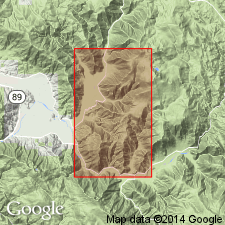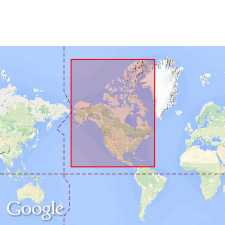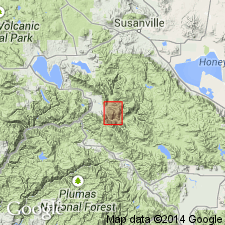
- Usage in publication:
-
- Hinchman sandstone
- Modifications:
-
- Named
- Dominant lithology:
-
- Sandstone
- AAPG geologic province:
-
- Sierra Nevada province
Summary:
Unit is named the Hinchman sandstone. Consists of greenish or gray sandrock, composed in many places of lapilli. Thickness is 500 ft. Overlies the Bicknell sandstone. Age is Late Jurassic. (B896)
Source: GNU records (USGS DDS-6; Menlo GNULEX).

- Usage in publication:
-
- Hinchman sandstone*
- Modifications:
-
- Adopted
- AAPG geologic province:
-
- Sierra Nevada province
Summary:
Pg. 51-52, pl. 3. Hinchman sandstone of Diller (1892) is adopted. Consists of 500 to 1,000 feet of coarse tuffaceous sandstone and conglomerate of andesitic material, with some shaly beds. Unconformably overlain by Foreman formation and grades into underlying Bicknell sandstone. Fossils (coral STYLINA). Age is Late Jurassic, based on fossils.
Source: Publication; US geologic names lexicon (USGS Bull. 896, p. 959); GNC index card files (USGS-Menlo).

- Usage in publication:
-
- Hinchman arkose
- Modifications:
-
- Not used
- AAPG geologic province:
-
- Sierra Nevada province
Summary:
Bicknell sandstone is included in the Hinchman arkose. Age is Late Jurassic. (B896)
Source: GNU records (USGS DDS-6; Menlo GNULEX).

- Usage in publication:
-
- Hinchman Sandstone*
- Modifications:
-
- Age modified
- AAPG geologic province:
-
- Sierra Nevada province
Summary:
Age of the Hinchman Sandstone is revised from Late Jurassic to: Middle Jurassic (Callovian).
Source: GNU records (USGS DDS-6; Menlo GNULEX).

- Usage in publication:
-
- Hinchman Formation*
- Modifications:
-
- Revised
- AAPG geologic province:
-
- Sierra Nevada province
Summary:
Hinchman Sandstone is everywhere revised to: Hinchman Formation owing to its lithic heterogeneity. Age is Middle Jurassic.
Source: GNU records (USGS DDS-6; Menlo GNULEX).
For more information, please contact Nancy Stamm, Geologic Names Committee Secretary.
Asterisk (*) indicates published by U.S. Geological Survey authors.
"No current usage" (†) implies that a name has been abandoned or has fallen into disuse. Former usage and, if known, replacement name given in parentheses ( ).
Slash (/) indicates name conflicts with nomenclatural guidelines (CSN, 1933; ACSN, 1961, 1970; NACSN, 1983, 2005, 2021). May be explained within brackets ([ ]).

